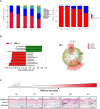Gram-Negative Bacteria and Lipopolysaccharides as Risk Factors for the Occurrence of Diabetic Foot
- PMID: 36974462
- PMCID: PMC10505552
- DOI: 10.1210/clinem/dgad178
Gram-Negative Bacteria and Lipopolysaccharides as Risk Factors for the Occurrence of Diabetic Foot
Abstract
Context: Imbalance of the skin microbial community could impair skin immune homeostasis and thus trigger skin lesions. Dysbiosis of skin microbiome may be involved in the early pathogenesis of diabetic foot (DF). However, the potential mechanism remains unclear.
Objective: To investigate the dynamic composition and function of the foot skin microbiome with risk stratification for DF and assess whether dysbiosis of the skin microbiome induces diabetic skin lesions.
Methods: We enrolled 90 consecutive subjects who were divided into 5 groups based on DF risk stratification: very low, low, moderate, and high risk for ulcers and a healthy control group. Integrated analysis of 16S ribosomal RNA and metagenomic sequencing of cotton swab samples was applied to identify the foot skin microbiome composition and functions in subjects. Then a mouse model of microbiota transplantation was used to evaluate the effects of the skin microbiome on diabetic skin lesions.
Results: The results demonstrated that, with the progression of diabetic complications, the proportion of gram-negative bacteria in plantar skin increased. At the species level, metagenome sequencing analyses showed Moraxella osloensis to be a representative core strain in the high-risk group. The major microbial metabolites affecting diabetic skin lesions were increased amino acid metabolites, and antibiotic resistance genes in microorganisms were abundant. Skin microbiota from high-risk patients induced more inflammatory cell infiltration, similar to the lipopolysaccharide (LPS)-stimulated response, which was inhibited by Toll-like receptor 4 (TLR4) antagonists.
Conclusions: The skin microbiome in patients with diabetes undergoes dynamic changes at taxonomic and functional levels with the progression of diabetic complications. The increase in gram-negative bacteria on the skin surface through LPS-TLR4 signal transduction could induce inflammatory response in early diabetic skin lesions.
Trial registration: ClinicalTrials.gov NCT04916457.
Keywords: 16S rRNA sequencing; diabetic foot; gram-negative bacteria; lipopolysaccharide; metagenome sequencing; skin microbiome.
© The Author(s) 2023. Published by Oxford University Press on behalf of the Endocrine Society.
Figures



Similar articles
-
Microbiome Characterization of Infected Diabetic Foot Ulcers in Association With Clinical Outcomes: Traditional Cultures Versus Molecular Sequencing Methods.Front Cell Infect Microbiol. 2022 Mar 24;12:836699. doi: 10.3389/fcimb.2022.836699. eCollection 2022. Front Cell Infect Microbiol. 2022. PMID: 35402307 Free PMC article.
-
Changes in Foot Skin Microbiome of Patients with Diabetes Mellitus Using High-Throughput 16S rRNA Gene Sequencing: A Case Control Study from a Single Center.Med Sci Monit. 2020 May 2;26:e921440. doi: 10.12659/MSM.921440. Med Sci Monit. 2020. PMID: 32358479 Free PMC article.
-
Analysis of the Composition and Functions of the Microbiome in Diabetic Foot Osteomyelitis Based on 16S rRNA and Metagenome Sequencing Technology.Diabetes. 2020 Nov;69(11):2423-2439. doi: 10.2337/db20-0503. Epub 2020 Aug 14. Diabetes. 2020. PMID: 32801139
-
Microbial Community Distribution and Core Microbiome in Successive Wound Grades of Individuals with Diabetic Foot Ulcers.Appl Environ Microbiol. 2020 Mar 2;86(6):e02608-19. doi: 10.1128/AEM.02608-19. Print 2020 Mar 2. Appl Environ Microbiol. 2020. PMID: 31924616 Free PMC article.
-
The role of the microbiome in ovarian cancer: mechanistic insights into oncobiosis and to bacterial metabolite signaling.Mol Med. 2021 Apr 1;27(1):33. doi: 10.1186/s10020-021-00295-2. Mol Med. 2021. PMID: 33794773 Free PMC article. Review.
Cited by
-
Sequence analysis of microbiota in clinical human cases with diabetic foot ulcers from China.Heliyon. 2024 Jul 9;10(14):e34368. doi: 10.1016/j.heliyon.2024.e34368. eCollection 2024 Jul 30. Heliyon. 2024. PMID: 39104504 Free PMC article.
-
Analyzing Immune Cell Infiltration and Copper Metabolism in Diabetic Foot Ulcers.J Inflamm Res. 2024 May 17;17:3143-3157. doi: 10.2147/JIR.S452609. eCollection 2024. J Inflamm Res. 2024. PMID: 38774446 Free PMC article.
-
Syndemics of Antimicrobial Resistance: Non-communicable Diseases, Social Deprivation, and the Rise of Multidrug-Resistant Infections.Infect Dis Ther. 2025 Aug;14(8):1561-1575. doi: 10.1007/s40121-025-01188-1. Epub 2025 Jul 3. Infect Dis Ther. 2025. PMID: 40610830 Free PMC article.
References
Publication types
MeSH terms
Substances
Associated data
LinkOut - more resources
Full Text Sources
Medical
Miscellaneous

